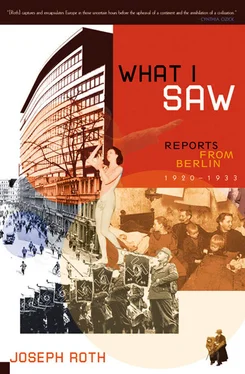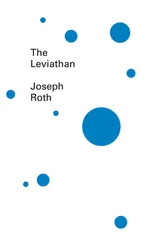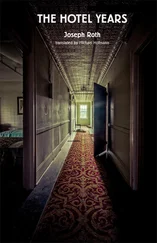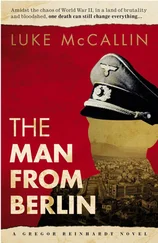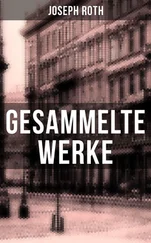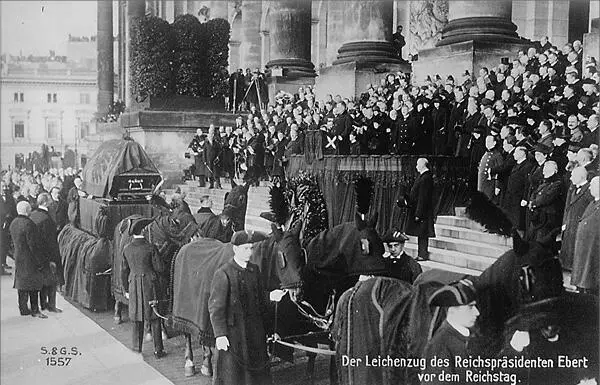
President Ebert’s funeral cortege outside the Reichstag.
There is the courtyard of the house. Resting along the walls are wreaths with colored ribbons, like visitors who have come a long way, and are tired. A few steps have decked themselves in thin black crepe. Suddenly they are not steps anymore that you climb to gain access to a house. They are signposts of grief. You pass up these steps, you don’t climb them. In the first room there are wreaths propped against the wall, waiting. People as they pass bend down to read what is written on the ribbons. It looks like a visitor greeting another visitor.
On the table lies a book for visitors to write their names. An ordinary book, quite small, bound in green cloth, a neutral sort of prop. After all, it only contains names. A lot of names, moving in their simplicity, names of ordinary people: Franz Kruleweit, innkeeper; Frieda Beckmann, guesthouse manager; Arnold Krug, war veteran; Robert Weitig, carpenter. Did they come so that they could say they had once been inside the house of the president of the Reich? Out of curiosity, making the most of the occasion? And maybe they were just curious when they set out. But by the time they wrote out their good, simple names, I am sure they were moved. Because they are simple people. It is easier for grief to find its way into the hearts of such people. They are not guarded by bitter skepticism.
It is an easy thing to feel moved in this house. The Reich’s Keeper of Paintings, Redslob, and the director, Jessner, have turned the small, relatively low-ceilinged rooms into spaces that elude conventional measurement. The walls are all draped in fine black cloth. The veiled mirrors are learning to live without light. It is no longer their purpose to reflect life, but to absorb death, to hide it in their silver surface, that is capable of producing so much depth. Colorful paintings mute their tones behind veils. Walls, corners, and ceilings seem to flow into one another in one softened, edgeless blackness. Only the candles that stand at either side of the bier are bare and uncovered, and the two honor guards. Their stillness softens the good, calming, golden light. There are gold chairs for the visitors. They seem no longer to be made of bright metal. It’s as though the chairs were carved from the yellow candlelight. Their splendor is undeniable, but grievously reinforced and simultaneously softened.
Outside, more and more people are now filing past the house. Confused carriages turn away, automobiles slow down, the closer they come, people pack together, treading on one another’s heels, shoulder to shoulder.
A memorial service for the dead man is held at twelve noon in the State Opera House on Königsplatz for the schoolchildren of Berlin. The orchestra of the State Opera plays Mozart’s K.477.* Max von Schillings conducts. The National and Cathedral Choirs sing under their choirmaster Professor Hugo Rudel. On either side of the stage are members of the government, seated on two rows of chairs. The Minister for Education, Arts, and Sciences, Professor Dr. Becker, addresses the young listeners. He reads a surprisingly well-written speech, objective for all its dignity, and interesting to follow in spite of its heavy use of stock phrases. The minister is a professor. To go by his speech (which was a sort of confession), not a born democrat, but one made from his understanding of the historical circumstances. He refers to the United States, where political struggle is every bit as intense as it is here, and where the death of a historical personage is nevertheless sufficient to silence the day-to-day arguments. He explains the difference between Bismarck’s centralized and authoritarian state and the ideal of antiquity: the res publica. He lends his support to the latter, and calls on his young audience to support it likewise. It is a politically significant speech, more democratic than one would have expected from such a man, and therefore thrice welcome. Marx† says a few words. Then the orchestra plays the Adagio from Bruckner’s Seventh Symphony. The hall is full of young people, pupils and students, and teachers of all ages. All those sitting here probably have some political affiliation. Many are probably on the far right, a long way from their education minister. And yet this ceremony must have made some impression on them. It would be nice to have a few more democratic ceremonies like this for teachers and students, without the melancholy occasion.
At one o’clock the streets of the city center are filled with a hurried dignity. People are trotting off somewhere or other, then just stop. Anxious automobiles are desperately looking for a way out. Heavy trucks roll slowly by. Coachmen stand up on their boxes and let their horses go where they will. Around the Reichstag everyone is pressed together, twelve deep, behind blue cordons of police. Anyone hoping to get into the Reichstag has to be pulled out by the police past eight pairs of shoulders. If you look out from the platform at the front of the Reichstag onto the expanse of Königsplatz, you see one enormous field of swaying faces. It’s as though the faces and the invisible bodies grew out of the ground, out of the lawn, and perhaps one could pluck some of these people. Above them are red and multicolored flags. They flower and unfurl. Policemen and soldiers stand around like leaden shapes: a watchful fence around an endless garden of humanity.
The Potsdam Station is no longer a station, no longer a gateway to the world, but a gateway to death. One descends black steps. Put away behind black cloths are all the noisy, merry sounds of a traveling, jingling, calling, tooting world. Signals are asleep, silent in silent corners. Do any trains still depart from here? Are there still such things as ticket counters, lights, red and green signals, switchmen? The waiting room has become an anteroom to eternity.
Outside, off to one side, where you can already make out the city streets, waits the hearse, all green on the inside with pine branches. It is an ordinary truck. Companies of men once sat in such trucks and rolled into the open arms of death. The truck bears a factual, undignified, meaningless number on its chest. It has been shrouded in black. Now the number looks like the black-bordered name of a mourner.
Outside the station the coffin stands on a catafalque. Incense is burning on both sides. The fragrance rises. Pine twigs have been spread over the paving stones, and muffle the stride of passersby. The coffin is all on its own, without any honor guard; given over to the street, the city, the people. No one guards it. The Reich flag is spread large and luminously over the coffin. It’s the visual equivalent of a farewell speech. You see it, and you understand what it says.
It grows dark. Life jingles, toots, and hammers. The coffin has disappeared. Travelers hurry in and out of the station. You hear the shout of a newspaper vendor. For the first time in years, piety — respect — has been more audible than the city’s normal clamor.
Frankfurter Zeitung, March 5, 1925
Part IX. Look Back in Anger
34. The Auto-da-Fé of the Mind (1933)
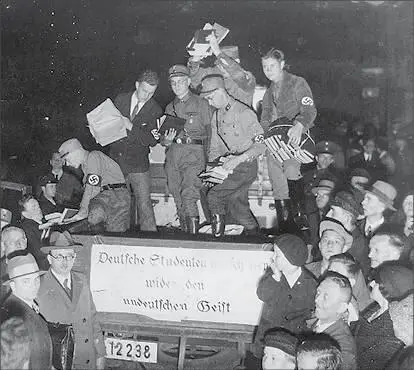
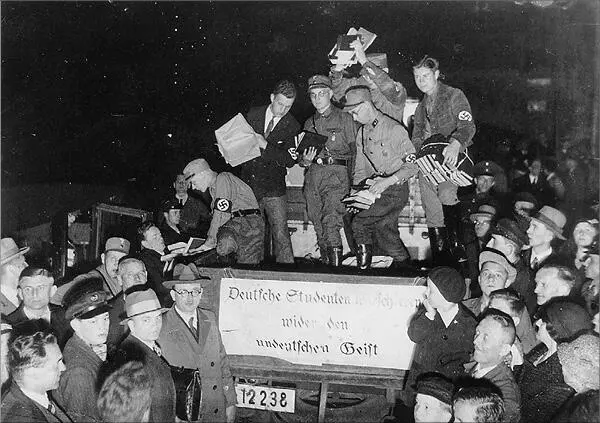
Very few observers anywhere in the world seem to have understood what the Third Reich’s burning of books, the expulsion of Jewish writers, and all its other crazy assaults on the intellect actually mean. The technical apotheosis of the barbarians, the terrible march of the mechanized orangutans, armed with hand grenades, poison gas, ammonia, and nitroglycerine, with gas masks and airplanes, the return of the spiritual (if not the actual) descendants of the Cimbri and Teutoni — all this means far more than the threatened and terrorized world seems to realize: It must be understood. Let me say it loud and clear: The European mind is capitulating. It is capitulating out of weakness, out of sloth, out of apathy, out of lack of imagination (it will be the task of some future generation to establish the reasons for this disgraceful capitulation).
Читать дальше
